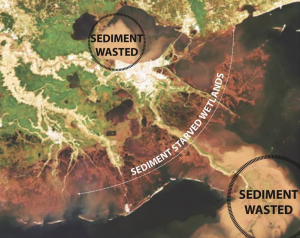New sediment counter shows amount of uncaptured sediment passing through LA every second
There’s less sediment moving down the Mississippi River than there used to be. Much of that missing material is trapped behind dams built upriver of Louisiana. Despite the reduction in sediment it carries, the Mississippi is still mighty with approximately 90 million tons of sediment passing the city of Belle Chasse, La. each year1. Tragically, much of that mud and sand will be carried past the sediment-starved wetlands and barrier islands of the delta – where it could have great benefits – and out into the Gulf, leaving us with a missed opportunity to restore health and resiliency to our coast.
The new sediment counter, published on the homepage of our website, shows the tons of sand and mud in the water that moves pass the USGS gage in Belle Chasse, La every second. For this counter, the sediment is estimated using the relationship between sediment and the flow of the Mississippi River at Belle Chasse for years 2008 to 2010, as described by Mead Allison, Ph.D. and others in the appendix of their 2012 paper, “A water and sediment budget for the lower Mississippi–Atchafalaya River in flood years 2008–2010: Implications for sediment discharge to the oceans and coastal restoration in Louisiana.” For more specific details, see “How we calculated uncaptured sediment.”
While there is no single solution for restoring our coast, it is vital that we treat sediment as the precious resource it is and maximize its capture and use for coastal restoration. The 2012 Coastal Master Plan identified two types of projects, marsh creation and sediment diversions, that use sediment to build and maintain land. Marsh creation projects dredge and pipeline sand from the river to strategically build new land. However, reliance on this project type alone means missing out on the mud that makes up at least 70 percent of the sediment that the river carries. Sediment diversion projects tap into both the sand the mud carried by the river to build new land and to help sustain the existing wetlands, that in the absence of sediment input, would continue to rapidly disappear.
Using these two types of restoration projects we can use the sand and mud – the foundation and lifeblood of the delta – to create a healthy and more resilient future for coastal Louisiana.
